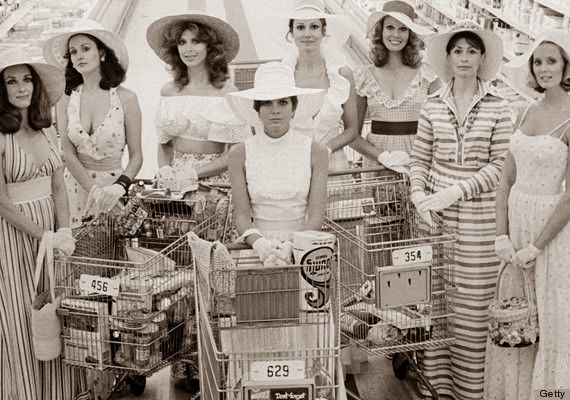ASPECTS OF SYNTHESIS WITHIN IMAGERY FOR THEORY INTO PRACTICE
For my publication i used the following images throughout to create the 1950's theme. I used these specific images to highlight important points through the housewife era.
For my introduction i used this image of eight ladies in a supermarket who seem to be portraying Step Ford wives. The photograph has been taken to capture the ladies in the supermarket shopping , probably doing the weekly food shop dressed up in not your usually food shopping attire. The women all have gloves on and long dresses also large hats. They look very elegant and glamours.
'Handsome is handsome does - Thats the GAS idea! - The advertisement uses an illustrated housewife in her kitchen holding this pot over the stove that is being advertised. The women in the 1950s have been portrayed to love household appliances and the ad encourages other women to do the same. It makes other women want and need the product because this housewife owns one. She is smiling as she's cooking the food and has her hair pinned , makeup freshly applied and looks well presented as all housewives are perceived they should be looking immaculate always.
I decided to use some black and white images throughout my publication so that i could have a mixture of advertising and photography. The lady in the image is in the kitchen making a list probably a shopping list or a to do list. She has food all over the table counter and the cupboard is open to show more food and more packaging.The lady is dressed smart/casual with her makeup and hair done.
This image is similar to the one above yet this shows the lady actually partaking in the usual day to day roles of the 1950s housewife with her ironing board and apron on. This photograph also clearly demonstrates the hard work housewives do as the lady has her hand pressed backwards on her forehead to show exhaustion.
Other advertisements and magazines pushed the idea that the wife should love what she does that being this housewife is the greatest job . They did this through everyday product advertising.This specific advertisement focuses on body image even though the message underlining is about working hard , working hard has no correlation to a womens or anyones looks. The focus of womens body image was at the for front of advertising just as much then as it is today.
Another black and white image portraying typical attributes of the 1950s housewife.
This image shows a women doting on her husband on his every needs and commands by showing the lady bringing him his breakfast with a smile and an affectionate hug.It shows the couple very happy together. Its gives the impression if every women behaves this way look how happy you could be!
Women started to dress more glamorous as a reflection of what was in the media at the time. The media willed women into believing that a more provocative sexual dress code would give them empowerment and self confidence. When in actual fact the whole idea behind it was for the males benefit.The advertising world was and still is at large ruled by men.
This advertisement shows how women became sexualised through advertising. The advert showing the lady in only her underwear with the slogan “ The lift that never lets you down” Glorify your figure. The bra is enhancing the lady’s breasts she is also looking into the mirror in flirtatious manner.The use of red lipstick reinforces the sexuality within the advert this specific choice has been made as anthropologists believe that red lips increase sex appeal.
This advertisement is a perfect example of objectification. The 50’s Ad uses a womens legs to sell the product. This style of advertising uses objectification in a way where it treats the model ultimately like an object or commodity without regard to their personality or dignity. The ad also uses illustrated roses as a symbolic reference to a lady’s private area. This connotes a reference to a lady’s virginity.
For the last two images i decided to use images i had found of women in the kitchen but women who are literally in there bras and knickers. In this advertisement it shows a modern day housewife with a retro theme. The advert has taken a more sinister tone its more sexualised and objectifying. This devalues the models worth and presents her as sexualised symbol of a housewife.
Even though the model is seen as an sexual object she still must full fill there stereotypical housewife duties.
The model in the advertisement displays many conventions of seduction. Such as - red lipstick , pursed lips, underwear , suspenders and body language.The portrayal of women in advertising is still to serve the man even his sexual desires. This is a signifier that a strong stereotype is always underlined throughout society over the past 60 years. As time has passed women’s portrayal has become more and more sexualised the stereotype still remains.















No comments:
Post a Comment